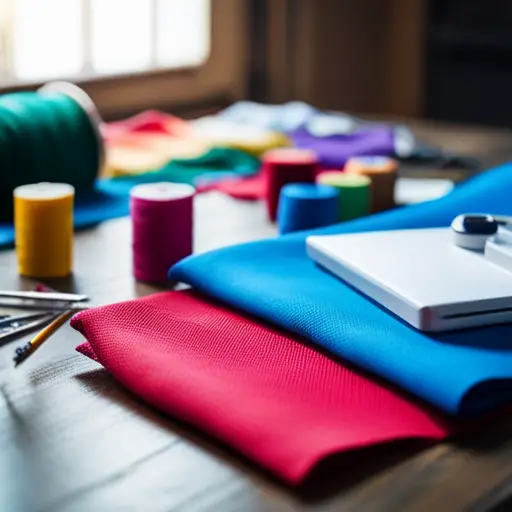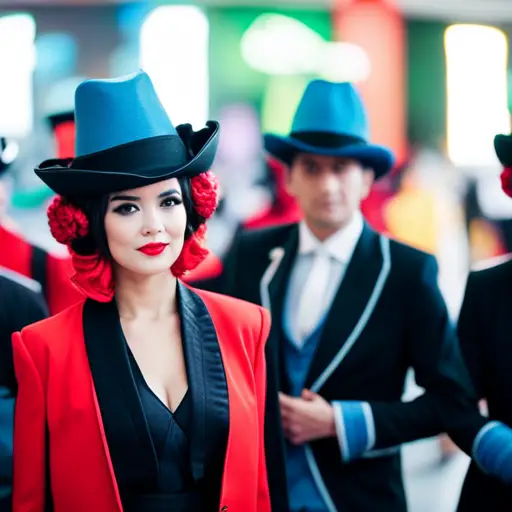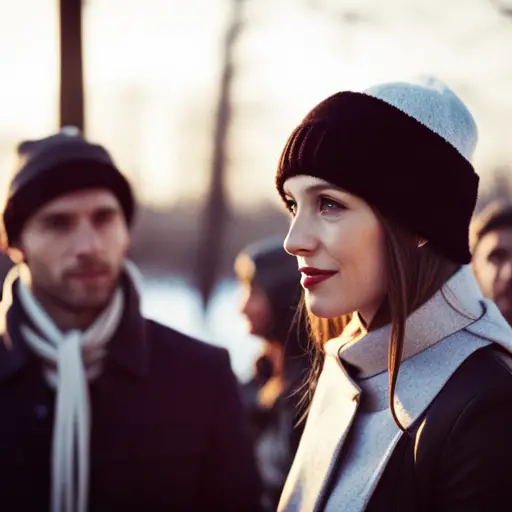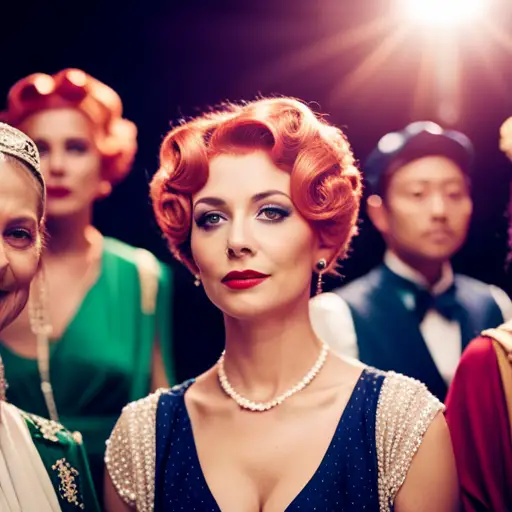DIY Costume Ideas for School Plays
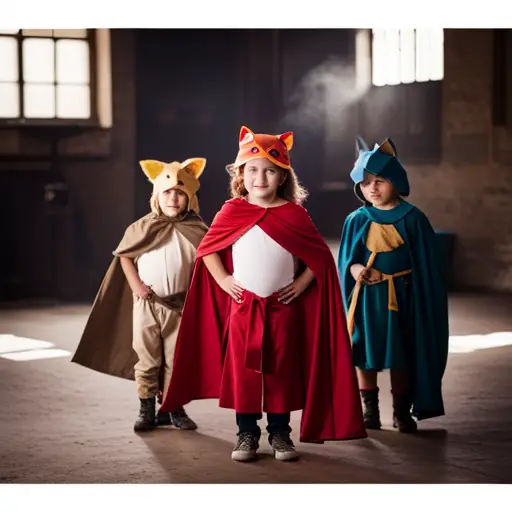
Did you know that 73% of schools incorporate DIY costumes into their school plays?
From historical characters to mythical creatures, there are endless possibilities for students to bring their characters to life on stage.
This article provides a comprehensive guide to DIY costume ideas for school plays, offering a wide range of creative and budget-friendly options for students and teachers alike.
Whether it’s a fairy tale favorite or a famous historical figure, these ideas are sure to inspire and impress.
Historical Characters
When creating DIY costumes for school plays, historical characters can be brought to life with authentic and recognizable attire. Historical fashion plays a significant role in portraying the essence of a specific era or character. For instance, the Tudor period in England is characterized by opulent and elaborate clothing, while the Roaring Twenties in America saw a shift towards more relaxed and daring styles. Incorporating historical fashion into DIY costumes adds depth and detail to the portrayal of characters, allowing the audience to immerse themselves in the time period being represented on stage.
Cultural influences are also pivotal in shaping historical fashion, as they reflect the values, traditions, and societal norms of a particular era. For example, traditional Chinese clothing, or Hanfu, has evolved over thousands of years and is deeply rooted in Chinese culture and history. By understanding the cultural influences on fashion, costume designers can create more authentic and respectful representations of historical characters, enriching the overall experience for both the performers and the audience.
Mythical Creatures
The portrayal of mythical creatures in school plays can captivate audiences with their fantastical allure and otherworldly presence, adding a sense of wonder and enchantment to the theatrical experience. Drawing from the historical and cultural influences discussed earlier, the incorporation of mythical creatures into DIY costumes offers a unique opportunity to explore the rich tapestry of folklore and legends, showcasing a diverse range of imaginative and visually captivating characters.
| Mythical Creature | DIY Costume Idea | Materials Needed |
|---|---|---|
| Dragon | DIY dragon wings | Cardboard, paint, elastic straps |
| Unicorn | Unicorn horn headbands | Polymer clay, headbands, paint |
| Phoenix | Feathered cape | Feathers, fabric, hot glue gun |
| Mermaid | Shimmering tail skirt | Shimmery fabric, elastic, sequins |
| Centaur | Horse costume | Brown fabric, faux fur, foam |
Fairy Tale Favorites
Continuing from the previous subtopic, one can explore the enchanting world of fairy tale favorites, which offer a wealth of imaginative characters and storytelling opportunities for school plays.
When it comes to fairy tale fashion, the key is to embrace the whimsical and fantastical elements that are often associated with these classic stories. From Cinderella’s iconic ball gown to Little Red Riding Hood’s cape, there are numerous opportunities for creative costume design.
Incorporating magical makeovers into the costumes can further enhance the enchantment of these characters. Adding sparkles, glitter, and ethereal accessories can transform ordinary clothing into extraordinary attire fit for a fairy tale.
Additionally, exploring the use of makeup and special effects can bring characters like fairies, witches, and enchanted creatures to life on stage. Whether it’s a prince, princess, or a mystical being, attention to detail and a touch of magic can truly elevate the portrayal of fairy tale characters in school plays.
Superheroes and Villains
Exploring the realm of superheroes and villains offers a new dimension of creativity and characterization for school play costumes, allowing students to embody the larger-than-life personas and moral complexities often associated with these archetypal figures.
For DIY cape designs, superhero and villain costumes can be brought to life using simple materials like old bedsheets or fabric. A classic cape can be made by cutting a large piece of fabric into a semi-circular shape and attaching strings to tie around the neck, while adding personalized emblems or symbols can enhance the uniqueness of each character.
Homemade mask ideas for superheroes and villains can be crafted using felt, cardboard, or even paper mache. For superheroes, bold and striking designs with vibrant colors can convey their heroic nature, while villains may feature darker, more sinister elements. Adding elastic bands or tying ribbons to the masks ensures a secure fit during performances.
These DIY costume elements enable students to fully immerse themselves in their roles, enhancing the overall theatrical experience and bringing these iconic characters to life on stage.
Classic Literary Figures
Entering the realm of classic literary figures provides an opportunity to delve into timeless characters and stories, offering students a chance to embody the depth and complexity of these iconic personas through DIY costumes. When it comes to classic literary figures, there are countless ways to bring these characters to life on the stage. Here are some creative ideas to consider:
-
DIY Shakespearean costumes, allowing students to interpret characters like Romeo, Juliet, Hamlet, or Ophelia in unique and imaginative ways.
-
Literary figure mashups, where students can combine characters from different literary works to create cross-genre costume ideas, such as a fusion of Alice in Wonderland and Sherlock Holmes.
-
Cross-genre costume ideas, like a futuristic version of Huckleberry Finn or a steampunk twist on Jane Eyre, offering a fresh take on familiar literary figures.
-
Incorporating symbolic elements to represent character traits, such as using colors, accessories, or props to convey the essence of the character in a visually impactful manner.
-
Encouraging students to research and develop their interpretations of classic literary figures, fostering creativity and a deeper understanding of the characters and their significance in literature.
Animal Kingdom Costumes
When it comes to bringing the animal kingdom to life on stage, there are several key elements to consider.
From animal masks and ears to tail and paw accessories, these details can elevate a costume and help the actor embody the character.
Earthy color palettes can also be used to evoke the natural essence of various animals, adding depth and authenticity to the overall look.
Animal Masks and Ears
One essential element of animal kingdom costumes for school plays is to incorporate a variety of animal masks and ears to bring characters to life. To create an immersive experience for the audience, consider the following elements:
-
Animal face paint and headbands: Utilize face paint to depict the unique features of different animals, and complement the look with headbands featuring attached animal ears for a realistic touch.
-
DIY animal tail and ears: Encourage creativity by crafting animal tails and ears using simple materials such as felt, wire, and headbands. This allows students to personalize their costumes and embody their chosen animal characters effectively.
Tail and Paw Accessories
Tail and paw accessories play a crucial role in adding realism and character to animal kingdom costumes for school plays.
Furry gloves and animal tails are essential for completing the look of animals such as cats, dogs, or bears. Furry gloves can mimic the appearance of animal paws and add a tactile element to the costume. Animal tails, whether they are long and swishy or short and stubby, can help bring the character to life.
Additionally, paw print face paint and whisker accessories can further enhance the overall appearance. Applying paw prints on the cheeks and using whisker accessories can add a playful and authentic touch to the costume.
These details contribute to the overall believability of the character and help students embody their animal roles convincingly.
Earthy Color Palettes
Continuing the theme of authenticity in animal kingdom costumes for school plays, the choice of earthy color palettes is essential for creating a natural and lifelike appearance. When selecting earthy color palettes for animal costumes, consider incorporating natural textures and earthy tone makeup to enhance the overall look. Here are some key elements to consider:
- Fur-like Fabrics: Utilize fabrics with natural textures to mimic animal fur, evoking a sense of warmth and comfort.
- Earthy Tones: Use earthy tone makeup to blend with the chosen earthy color palette, enhancing the organic and authentic feel of the costume.
- Organic Accessories: Incorporate natural elements such as twigs, leaves, or grass to add depth and realism to the costume.
- Earthy Hues: Choose colors like browns, greens, and tans to reflect the natural environment of the animal.
- Subtle Details: Pay attention to intricate details to capture the essence of the animal’s natural habitat and characteristics.
Transitioning into the subsequent section about ‘science fiction and fantasy’, the fusion of creativity and imagination takes center stage.
Science Fiction and Fantasy
As we shift our focus to the realm of Science Fiction and Fantasy, we will explore the art of creating otherworldly characters.
From mastering alien makeup techniques to crafting DIY wizard robes and fantasy creature accessories, this subtopic offers a plethora of creative opportunities for school play costumes.
Whether it’s bringing extraterrestrial beings to life or embodying mystical wizards, these costume ideas will add an enchanting and imaginative touch to any performance.
Alien Makeup Techniques
Alien makeup techniques for science fiction and fantasy characters can enhance the visual impact of school plays, adding an otherworldly dimension to the performances. To create a truly mesmerizing effect, consider the following special effects:
- Luminescent face paint to give an ethereal glow
- Prosthetic alien features such as elongated ears or forehead ridges
- Glitter and metallic accents for an otherworldly shimmer
- Bold, unconventional color palettes for a striking and surreal appearance
- UV-reactive makeup for an otherworldly glow under blacklight
These techniques can provide costume inspiration and help actors embody their alien characters convincingly.
Transitioning into the subsequent section about ‘diy wizard robes,’ the next step is to explore how to bring magical characters to life through costume and makeup.
DIY Wizard Robes
To further elevate the visual impact of school plays, consider crafting DIY wizard robes for science fiction and fantasy characters, enhancing the overall enchanting and mystical atmosphere of the performances.
When creating DIY wizard robes, focus on using rich, flowing fabrics in deep, dramatic colors to evoke a sense of otherworldly power. Adding details such as wide sleeves, ornate trimmings, and a dramatic hood can further enhance the magical aesthetic.
Additionally, incorporating DIY wizard wands as magical accessory ideas can complement the wizard robes and add an extra touch of authenticity to the costumes. Consider using materials such as wooden dowels, hot glue, and metallic paint to craft unique and personalized wizard wands that will captivate the audience and bring the characters to life on stage.
Fantasy Creature Accessories
For a captivating and immersive portrayal of science fiction and fantasy characters in school plays, consider incorporating DIY fantasy creature accessories. These accessories, such as intricate masks and elaborate wings, can further enrich the visual storytelling and transport the audience to otherworldly realms.
-
DIY dragon scales: Adding DIY dragon scales to costumes can instantly transform actors into fierce and majestic creatures, evoking a sense of awe and enchantment in the audience.
-
Unicorn horn headbands: Crafted unicorn horn headbands can bring a touch of magic and whimsy to characters, allowing them to embody the grace and elegance of these mythical beings.
-
Elaborate wings: DIY wings can lend an air of mystery and grandeur to characters, enabling them to take flight and mesmerize the audience with their ethereal presence.
-
Intricate masks: Intricately designed masks can conceal identities and unleash the imagination, imbuing characters with an enigmatic allure that captivates the audience.
-
Fantasy-themed jewelry: Incorporating DIY fantasy-themed jewelry, such as amulets and talismans, can infuse characters with an aura of ancient wisdom and mystique, captivating the audience with their symbolic significance.
Famous People From History
Famous historical figures’ costumes can bring history to life on stage and help students embody the characters they are portraying. When it comes to famous people from history, there are numerous options for costumes, ranging from famous inventors and scientific pioneers to notable politicians and social reformers. Here are some DIY costume ideas for school plays based on famous people from history:
| Famous Inventors/Scientific Pioneers | Notable Politicians/Social Reformers | Other Notable Figures |
|---|---|---|
| Thomas Edison | Abraham Lincoln | Cleopatra |
| Marie Curie | Mahatma Gandhi | Joan of Arc |
| Alexander Graham Bell | Nelson Mandela | Queen Elizabeth I |
| Isaac Newton | Susan B. Anthony | William Shakespeare |
| Leonardo da Vinci | Martin Luther King Jr. | Florence Nightingale |
These historical figures can inspire students to learn about the contributions and impact these individuals had on society. By wearing their costumes, students can immerse themselves in the roles and bring these influential figures to life on stage.
Frequently Asked Questions
How Can I Incorporate Technology Into My Science Fiction or Fantasy Costume?
Incorporating technology into a science fiction or fantasy costume can be achieved through costume accessories such as LED lights, fiber optics, or interactive components like motion sensors and sound effects, enhancing the overall futuristic or magical effect.
Are There Any DIY Costume Ideas for Famous People From History That Don’t Require Elaborate Props or Accessories?
When looking for DIY costume ideas for historical figures, a minimalistic approach can be effective. Consider using simple clothing and accessories to embody iconic individuals from history. Focus on capturing the essence of the figure through posture and demeanor.
Can You Provide Tips for Creating a DIY Costume for a Classic Literary Figure That Is Both Historically Accurate and Budget-Friendly?
When creating a DIY costume for a classic literary figure, focus on historical accuracy and staying within budget. Utilize technology for creative solutions and consider incorporating fantasy elements to bring the character to life.
What Are Some Unique DIY Costume Ideas for Mythical Creatures That Go Beyond the Typical Dragon or Unicorn?
Exploring diverse DIY costume options for mythical creatures beyond the conventional dragon or unicorn can captivate audiences. Unique ideas may blend technology, science fiction, and fantasy elements, enriching the portrayal of these legendary beings.
Are There Any DIY Costume Ideas for Historical Characters That Are Appropriate for a Diverse Range of Cultures and Time Periods?
When considering cultural diversity and timeless characters for DIY historical costumes, it is important to prioritize respectful and accurate representation. Incorporating traditional attire, such as kimonos, saris, or togas, can showcase the rich tapestry of global history.
Conclusion
In conclusion, when choosing DIY costume ideas for school plays, there are several categories to consider:
- Historical characters: This includes figures such as Abraham Lincoln, Cleopatra, or Joan of Arc. These costumes can be created using period-appropriate clothing and accessories.
- Mythical creatures: Students can portray characters like unicorns, mermaids, or dragons. These costumes often involve creating intricate and imaginative designs.
- Fairy tale favorites: Characters like Cinderella, Snow White, or the Big Bad Wolf can be brought to life through DIY costumes made with everyday clothing items and props.
- Superheroes and villains: Students can choose to dress up as their favorite comic book characters, such as Spider-Man, Wonder Woman, or the Joker. These costumes can be made using store-bought or homemade materials.
- Classic literary figures: Characters like Sherlock Holmes, Alice in Wonderland, or Tom Sawyer can be portrayed through DIY costumes that reflect their distinctive traits and attire.
- Animal kingdom costumes: Students can dress up as their favorite animals, whether it be a lion, a panda, or a penguin. These costumes can be created using clothing items and accessories that resemble animal features.
- Science fiction and fantasy: Students can choose to portray characters from popular science fiction or fantasy franchises, such as Star Wars, Harry Potter, or Lord of the Rings. These costumes often involve creating unique and elaborate designs.
- Famous people from history: Students can choose to portray historical figures like Albert Einstein, Amelia Earhart, or Martin Luther King Jr. These costumes can be created using clothing and accessories that reflect the time period and style.
For example, a student may choose to portray Albert Einstein in a school play. They can create a DIY costume by using a white lab coat, styling their hair in a wild manner, and wearing a fake mustache to bring the character to life on stage.

